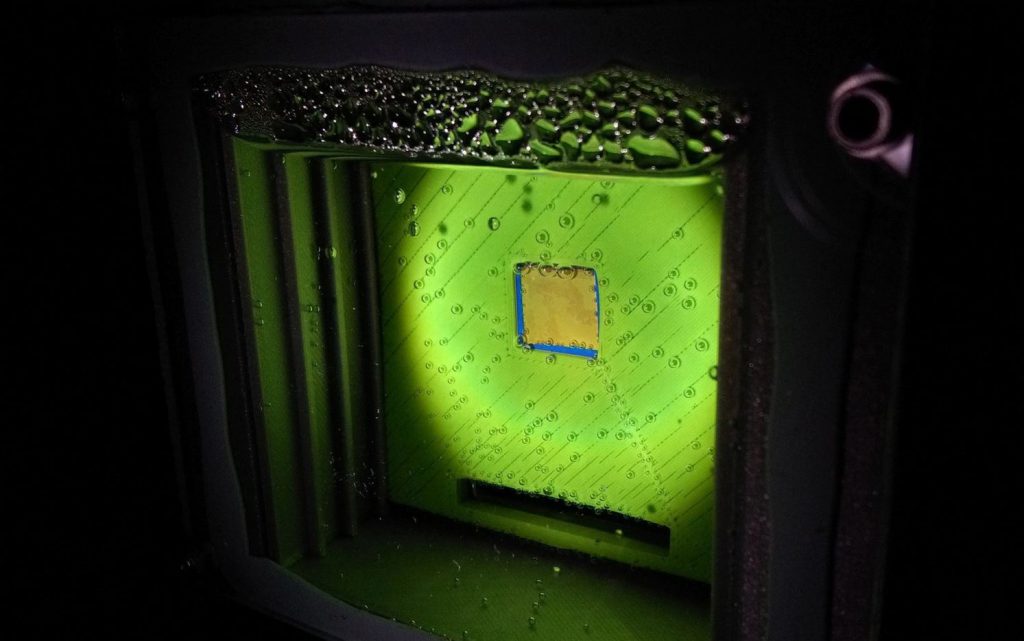Researchers produce clean gas from CO2 and water

The 'artificial leaf' uses water, sunlight and carbon dioxide to produce a widely-used gas Credit: Cambridge University
Researchers at the University of Cambridge in England have come up with a novel way to produce a widely-used gas that is currently produced from fossil fuels.
The researchers have discovered that they can directly produce the gas – called syngas – from an artificial leaf that uses only sunlight, carbon dioxide and water.
This development was first reported Wednesday October 22 in the journal Nature Materials.
The hope is that the technique can eventually be used to develop a sustainable liquid fuel alternative to gasoline (or petrol as it is known in the U.K.).
“You may not have heard of syngas itself but every day, you consume products that were created using it,” said Professor Erwin Reisner of the Cambridge Department of Chemistry. He was speaking in an interview with SciTechDaily. “Being able to produce it sustainably would be a critical step in closing the global carbon cycle and establishing a sustainable chemical and fuel industry,” he said. Reisner has spent several years working to achieve this goal.
Syngas is currently made from a mixture of hydrogen and carbon monoxide, and is used to produce a range of commodities, including pharmaceuticals, plastics and fertilizers.
The artificial leaf that Reisner and his colleagues have come up with is inspired by photosynthesis – the natural process by which plants use the energy from sunlight to turn carbon dioxide into food.
On the artificial leaf, two light absorbers, similar to the molecules in plant that harvest sunlight, are combined with a catalyst made from the naturally abundant element called cobalt.
When the device is immersed in water, one light absorber uses the catalyst to produce oxygen. The other carries out the chemical reaction that reduces carbon dioxide and water in carbon monoxide and hydrogen, forming the syngas mixture.
The good news is that the light absorbers work even under the low levels of sunlight on days when it is raining or overcast.
The research was carried out in the Christian Doppler Laboratory for Sustainable SynGas Chemistry in the University’s Department of Chemistry. It was co-funded by the Austrian government and the Austrian petrochemical company OMV, which is looking for ways to make its business more sustainable.
Other artificial leaf devices have also been developed, but these usually only produce hydrogen. The Cambridge researchers say the reason they have been able to make theirs produce syngas sustainably is thanks to the combination of materials and catalysts that were used.
Syngas is already used as a building block in the production of liquid fuels. “What we’d like to do next, instead of first making syngas and then converting it into liquid fuel, is to make the liquid fuel in one step from carbon dioxide and water,” Reisner said.
He said the development of synthetic petrol is vital as electricity can currently only satisfy about 25% of the world’s energy demand.

Can the eminent professor and his research team also address the following questions:
1. Can the reforestation efforts and number of new trees planted and actual coverage of tree landmass loss per year adequately keep pace with the lightning speed of deforrestation and decimation of trees for wood, lumbar, construction, housing and One-Belt-and Road /CPEC and other mega highway and road network projects that are essentially touted as hallmarks of economic development?
2. How much impact quantitatively will syngas have on demand in terms of substitution by cutting down fossil fuel consumption?
3. What is the comparable cost of syngas vis-a-vis fossil fuels and whether it offers economy and easy accessibility at the pump?
By initial study findings syngas what is the gestational period to produce, store, market and distribute syngas and the cost benefit feasibility?